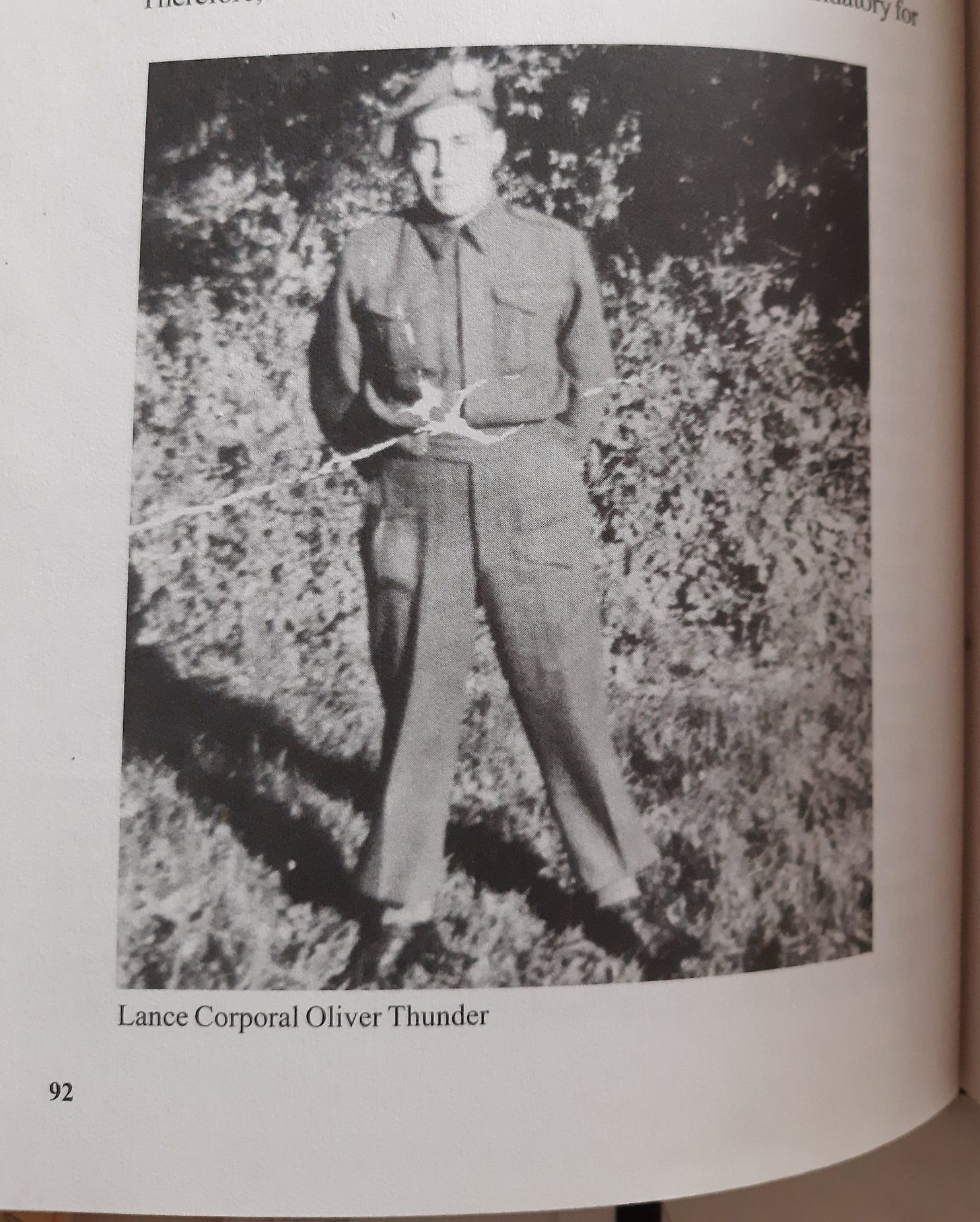Lance Corporal Oliver L. Thunder
killed in combat while fighting in France at the Battle of Verrieres Ridge
When the Germans invaded Poland in 1939, Canada declared war on Germany. Oliver L. Thunder was 17 years old. He was born in Minnesota in 1922, but was living with his parents, Tom and Sarah Thunder, in Middlebro, Manitoba, when the war began.
Last week I wrote about his parents, Tom and Sarah Thunder. Oliver’s father, Tom, was the great-grandson of Chief Ay Ash Wash of Buffalo Point, who had signed Treaty 3 in 1873. Oliver’s mother, Sarah, was the granddaughter of Warroad settler Duncan Begg, a Scottish-Métis translator at Treaty 3 negotiations.
Oliver Thunder, like his parents, grew up on Lake of the Woods. He enlisted in The Queen’s Own Cameron Highlanders of Canada.

This infantry unit was organized in Winnipeg even before WWI when the Scottish community, especially the St. Andrew’s Society, pushed for a highland regiment. The Cameron Highlanders fought valiantly wearing kilts in WWI, though they wore combat uniforms in WWII.
I found this silent video from May of 1940 of the Cameron Highlanders marching in Ottawa before they left for the war.
While the United States would not enter the conflict until December of 1941 — after the bombing of Pearl Harbor — Canada started to send troops to Europe in 1939.
Oliver Thunder was promoted to Lance Corporal and led men into combat missions in Europe.
On June 6, 1944, about 160,00 Allied soldiers landed on the shores of Normandy and their operations proved a key turning point in the war against the Nazis.
But the war was not won on D-day. The Normandy invasion took place over the course of three months. Victory in Europe would not be declared until May of 1945.
It took six weeks from D-Day to push three divisions of Nazi SS Panzer tanks back from the beaches where troops landed, forcing them south from the English Channel and west toward Paris.
On July 19, the Allies finally took the city of Caen, which had largely been leveled.
For the Cameron Highlanders, their next mission was about five miles south at the Battle of Verrieres Ridge.

Craig Baird of
recorded an episode of his podcast on the Battle of Verrieres Ridge, one of the fiercest clashes during WWII for the Canadian forces. The encounter with the enemy began on July 19, 1944.The Cameron Highlanders — as part of the 6th Infantry Brigade — participated in the joint operation on July 20, 1944, at St. Andre-sur-Orne.
From their vantage above the ridge, Nazi SS Panzer tanks fired artillery and mortar rounds down upon the Camerons advancing in the open farm fields of grain with only a handful of barns and houses for cover.
The Queen’s Own Cameron Highlanders sustained heavy losses throughout the next day. And then it rained hard through the night.
Oliver L. Thunder died on July 22 on a muddy battlefield.
He is one of 2,793 Canadian soldiers buried at Bretteville-sur-Laize Canadian War Cemetery, which is about 10 miles south of Caen in Normandy, France.
The battles in Normandy in the summer of 1944 claimed the lives of 20,000 French citizens, 23,000 German soldiers, and 73,000 members of the Allied Forces.
Fifteen million soldiers died worldwide during WWII, according to data from the National World War II Museum in New Orleans.
The freedoms I took for granted my entire life are because Oliver Thunder and so many others sacrificed their lives to stop the global spread of fascism.




Keep it up! History needs to be shared and spread, not hidden, destroyed, or whitewashed. I love seeing history for what it was.
This puts a lot into perspective. Thanks for researching and sharing this information, Jill. My sister and I plan to embark this year on a study of our ancestral roots in Quebec.